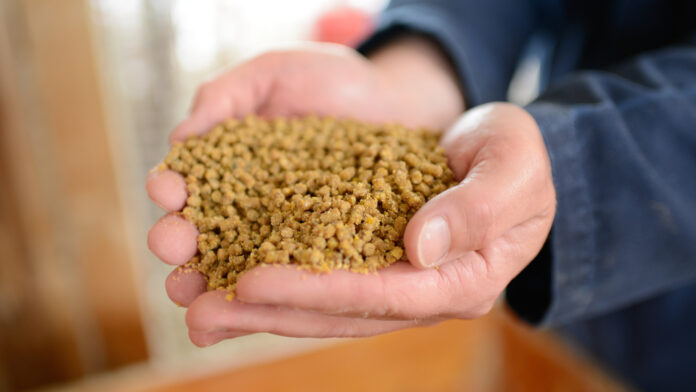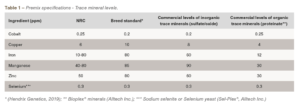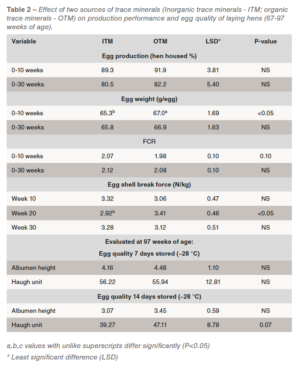
Common industry practice is to supply trace minerals well above published recommendations. An experiment was conducted to examine the effects of two commercial premixes with common levels of trace minerals (Cu, Mn, Fe, Zn) in inorganic form or reduced levels of trace minerals in organic form on production performance of laying hens, egg weight, egg and shell quality.
A. Kocher1, A. Kumar2, S. Nicholson1 and T. Tiller3
1 Alltech Lienert, Roseworthy SA
2 School of Agriculture and Food Sciences, The University of Queensland, Gatton
3 Alltech Thailand, Bangkok
The study showed that the use of low levels of organic trace minerals in the diets had no impact on egg production or feed conversion ratio. However, birds fed organic trace minerals had heavier eggs in the first 10 weeks (0-10 weeks) and increased eggshell strength measured in week 20 (P<0.05). In addition, there was a tendency for improved egg quality after storage (P=0.07) in diets with organic trace minerals.
Introduction
It is well known that essential trace minerals such as zinc, copper, manganese or iron are involved in hormone, enzyme, carbohydrate protein or nucleic acid metabolism. Insufficient levels of trace minerals in a diet can lead to poor health and subsequently poor performance. Trace minerals are a very small part of the overall cost of a diet which allows nutritionists to use high safety margins (2-5x NRC levels) in their feed formulations. As such, trace mineral requirements for modern poultry production is poorly researched and most commercial diets include levels that are well above the NRC recommendations published over 25 years ago. More recently, a better understanding of the correlations between trace mineral use and excretion into the environment, trace mineral loads and antimicrobial resistance and the increase in contamination with toxic heavy metals alerted the European Feed Safety Authority (EFSA) to critically review the use and overuse of trace elements. In addition, a better understanding of the role of inorganic trace minerals in feed, in particular the negative interactions with vitamin or endogenous feed enzymes, raised serious doubts about current practices. The availability and use of more bioavailable organic trace minerals have reignited the debate on appropriate levels of trace minerals in poultry diets. Work in broilers showed that using low levels of organically bound trace minerals had no impact on broiler performance but significantly lowered excretion rate of these minerals. Similarly, a study by Abdallah et al. (1994) showed that removing all supplementary trace minerals from layer diets for 10 weeks had no effect on laying performance of hens, but significantly decreased egg shell weight. Despite the fact that organic trace minerals are protected from interaction between minerals, it is important to understand the limiting levels of each mineral. A series of experiments by Bao et al. (2010) established that Zn is the first limiting trace mineral among Cu, Mn, Fe and Zn. These limitations need to be taken into consideration in commercial feed formulations. The objective of this study was to determine the effects of a commercially available layer premix with reduced levels of trace minerals in organic form.
Materials and methods
One hundred and forty-four ISA brown laying hens (64 weeks of age, standard vaccination program at rearing) were randomly allocated in groups of 4 hens (n=4) and housed in an experimental layer facility at the University of Queensland, Gatton in standard layer cages (650cm2/bird stocking density). Birds were fed a commercial layer diet for 3 weeks. At the start of the experimental period, cages were divided into two groups of uniform egg production and allocated to experimental diets with either inorganic trace minerals at industry levels (ITM) or organic trace minerals at low levels (OTM) (Table 1) with 18 replicates of 4 hens each.
During the 30-week experimental period – 67 to 97 weeks of age – per cage daily egg production, egg weight and feed intake was measured. At the end of week 10, 20 or 30 respectively one egg from each cage was selected (n=18) and eggshell breaking strength was measured using an Egg Force Reader (Egg Multi Tester-EMT-5200, Robotmation Co. Ltd Tokyo Japan). Quality of eggs stored at room temperature was measured at the end of the experiment (one egg per cage, n=18) using an Egg Analyzer TH (EMT-5200). SAS systems (SAS Institute Inc., 2001) was used to perform the statistical analyses used in this study. Data were subjected to analysis of variance (ANOVA). Least significant differences between means was used to test for the probability of significant (P<0.05) differences between means.
The study was conducted to the standards set by The University of Queensland Animal Ethics Committee and Australian Model Code of Practice for the Welfare of Animals –Domestic Poultry 4th Edition, 2002 (UQ study number C03360-001).
Results and discussion
Overall performance throughout the study was excellent and slightly above the expected target production for the breed (Hendrix Genetics, 2019). The source and level of trace minerals had no effect on laying performance or feed conversion although laying performance of birds fed organic trace minerals remained numerically higher during the experimental period (Table 2). Hence, trace minerals from organic sources supplemented at levels notably lower than commercial levels can maintain optimal growth and production performance.

These findings are in line with work by Stefanello et al. (2014) which showed that feeding similar levels of Mn, Zn, and Cu resulted in higher eggshell thickness compared to inorganic sources at the same level. Stefanello et al. (2014) showed that mineral levels had a quadratic effect on egg weight and eggshell quality. These researchers were also able to demonstrate a significant increase in egg weight (P<0.05) in birds supplemented with organic trace minerals and linked the increase in egg weight to improved eggshell thickness due to higher mineral supplementation. Similarly, work by Rutz et al. (2004) reported a significant interaction between the dietary effect of trace mineral source and eggshell thickness when Mn and Zn were supplemented at similar levels to the current study. Eggshell thickness and egg production were significantly improved when layers were supplemented with organic trace minerals (P<0.05).
It is well known that trace minerals are involved in various aspects of the formation of eggshell and an increased availability in Mn, Zn and Cu results in higher shell strength and better quality in the eggshell formation. Despite the reduced levels of trace minerals in the feed, supplementation of organic trace minerals had no negative impact on shell quality. In the current study, the increase in egg weight and the eggshell strength in birds fed organic trace minerals was equal to or improved compared to supplementation with inorganic trace minerals. Haugh units in eggs from birds fed organic trace minerals remained higher (P<0.07) when stored for 14 days at room temperature. Although it is inevitable that Haugh units will decrease over time, the positive effect of organic trace minerals has been previously reported by Batista et al. (2017).
The results of the present study show that the use of commercial premixes with organic trace minerals at lower levels than common industry practice has no negative impact on laying performance but has a beneficial effect on eggshell and egg quality.
References are available on request
From the Proceedings of the Australian Poultry Science Symposium 2020
















